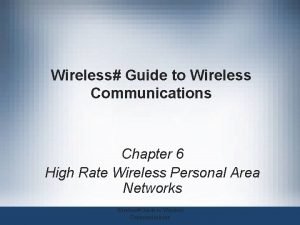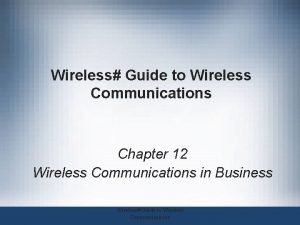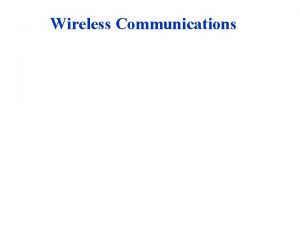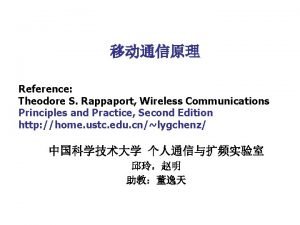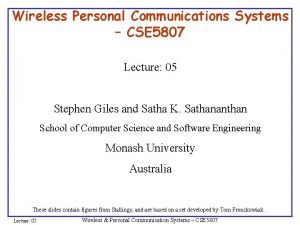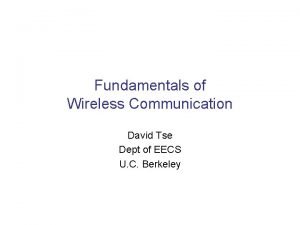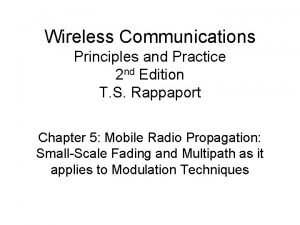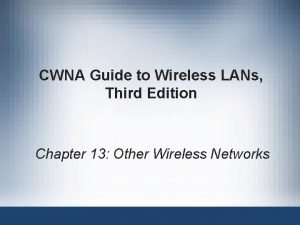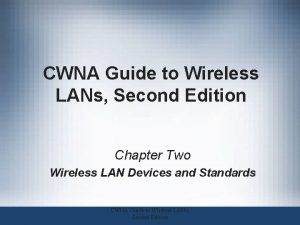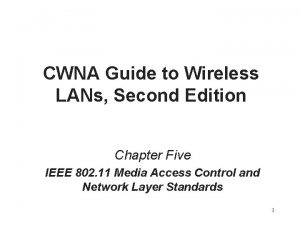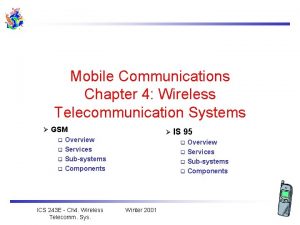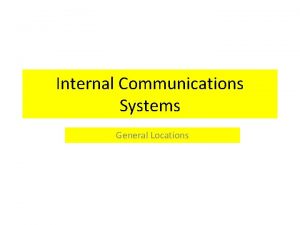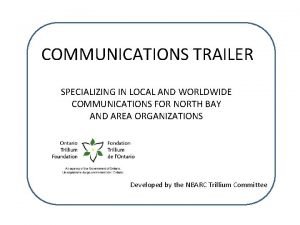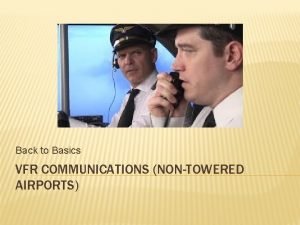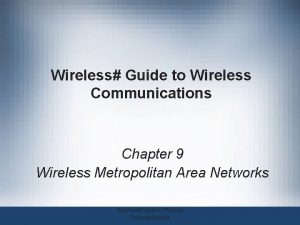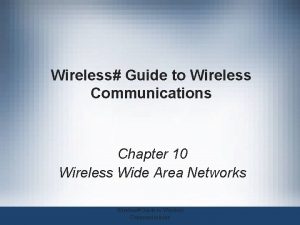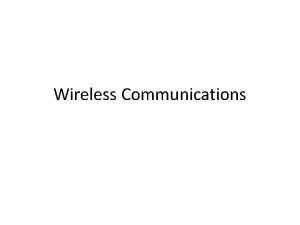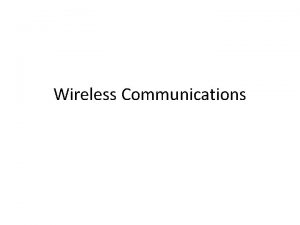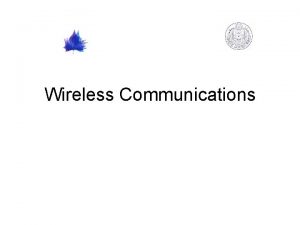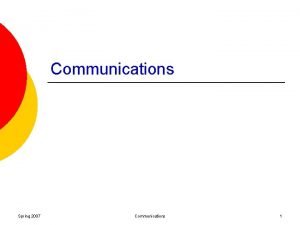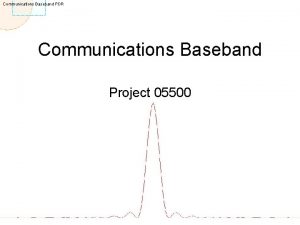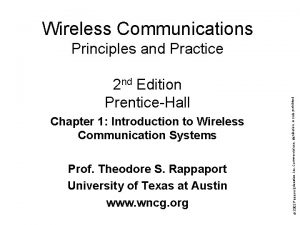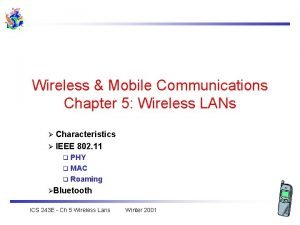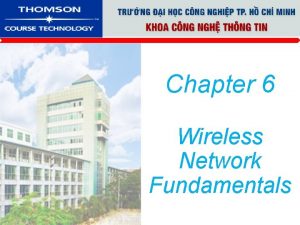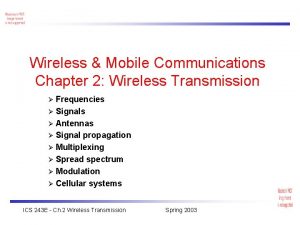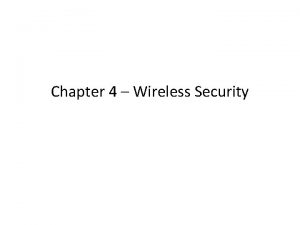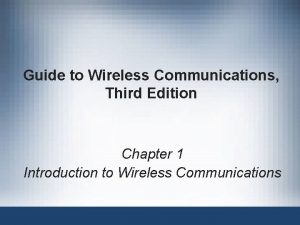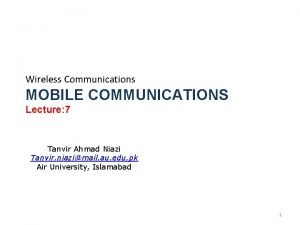Wireless Guide to Wireless Communications Chapter 4 How


























































- Slides: 58

Wireless# Guide to Wireless Communications Chapter 4 How Antennas Work Wireless# Guide to Wireless Communications

Objectives • Define decibels, gain, and loss • Outline the purpose of an antenna • List the different antenna types, shapes and sizes, and their applications • Explain RF signal strength and direction • Describe how antennas work Wireless# Guide to Wireless Communications 2

Gain and Loss • Understanding RF signal transmission involves: – The strength or the power with which the transmitter is sending the signal – The amount of reduction in signal strength caused by cables, connectors, and other components – The transmission medium (atmosphere or free-space) – The minimum strength of the signal required by the receiver to be able to properly recover the data sent by the transmitter Wireless# Guide to Wireless Communications 3

Gain and Loss (continued) • Amplifier boosts the power of a signal – The effect is called a gain • Cables and connectors offer a resistance to the flow of electricity – They tend to decrease the power of a signal (loss) • Signal power changes logarithmically • Gain and loss are relative concepts – Need to know the power level of the signal at two different points Wireless# Guide to Wireless Communications 4

Gain and Loss (continued) Wireless# Guide to Wireless Communications 5

The Decibel • Decibel (d. B) – Ratio between two signal levels – Makes it much simpler to express and calculate power gain or loss • Tens and threes of RF mathematics – A gain of 3 d. B (+3 d. B) means the signal is two times bigger (twice the power) – A gain of 10 d. B (+10 d. B) means the signal is 10 times bigger (10 times the power) – The same applies for loss Wireless# Guide to Wireless Communications 6

The Decibel (continued) • d. Bm – Relative way to indicate an absolute power level in the linear Watt scale – 1 m. W = 0 d. Bm • Isotropic radiator – Theoretical perfect sphere that radiates power equally in all directions – Provides a reference point for representing the gain of an antenna • Usually expressed in d. B isotropic (d. Bi) Wireless# Guide to Wireless Communications 7

The Decibel (continued) • For microwave and higher frequency antennas – Gain is usually expressed in d. B dipole (d. Bd) • Dipole – The smallest, simplest, most practical type of antenna that can be made • But that also exhibits the least amount of gain – Has a fixed gain over that of an isotropic radiator of 2. 15 db Wireless# Guide to Wireless Communications 8

The Decibel (continued) Wireless# Guide to Wireless Communications 9

Antenna Characteristics • Characteristics of antennas – Types, sizes, and shapes Wireless# Guide to Wireless Communications 10

Antenna Types • Passive antennas – The most common type – Constructed of a piece of metal, wire, or similar conductive material – Does not amplify the signal in any way – Directional gain • Passive antennas radiate the RF energy supplied by the transmitter in one direction • Exhibits an effective gain that is similar to amplification of the signal Wireless# Guide to Wireless Communications 11

Antenna Types (continued) • Active antennas – Essentially passive antennas with an amplifier built-in – Amplifier is connected directly to the piece of metal that forms the antenna itself – Most active antennas have only one electrical connection • RF signal and the power for the amplifier are supplied on the same conductor Wireless# Guide to Wireless Communications 12

Antenna Sizes and Shapes • Size and shape of an antenna depend on: – Frequency on which the antenna will transmit and receive – Direction of the radiated electromagnetic wave – Power with which the antenna must transmit • Antenna size is inversely proportional to the wavelength it is designed to transmit or receive – Lower frequency signals require larger antennas Wireless# Guide to Wireless Communications 13

Antenna Sizes and Shapes (continued) • Omnidirectional antennas – Used to transmit and receive signals from all directions with relatively equal intensity – Longer omnidirectional antennas have a higher gain • Directional antennas – Transmit a signal in one direction only – Yagi antenna emits a wider, less focused RF beam – Parabolic dish antenna emits a narrow, more concentrated beam of RF energy Wireless# Guide to Wireless Communications 14

Antenna Sizes and Shapes (continued) Wireless# Guide to Wireless Communications 15

Antenna Sizes and Shapes (continued) Wireless# Guide to Wireless Communications 16

Antenna Sizes and Shapes (continued) Wireless# Guide to Wireless Communications 17

Antenna Sizes and Shapes (continued) • Patch antennas – Emit an RF energy beam that is horizontally wide but vertically taller than that of a yagi antenna – Considered a semi-directional antenna – Often used to send RF energy down a long corridor – Some are designed for installation on building walls • To send an RF signal in one direction away from the structure – One common application for patch antennas is in cellular telephony Wireless# Guide to Wireless Communications 18

Antenna Sizes and Shapes (continued) Wireless# Guide to Wireless Communications 19

Antenna Sizes and Shapes (continued) Wireless# Guide to Wireless Communications 20

Signal Strength and Direction • Distance between the transmitter and receiver – Determines the strength of the signal • Transmitters produce a finite amount of RF energy – For most applications, active antennas can be extremely expensive • Omnidirectional antenna divides strength of signal in a 360 -degree circle around the antenna • Free space loss – RF waves tend to spread away from the source of the signal (the antenna) Wireless# Guide to Wireless Communications 21

How Antennas Work • Understanding antennas requires in-depth knowledge of physics, mathematics, and electronics Wireless# Guide to Wireless Communications 22

Wavelength • Length of a single RF sine wave • Determines the size of an antenna • Full-wave antenna – Antenna transmits and receives a signal most efficiently at a specific frequency • When it is as long as the full length of the wave – In most cases, this is not practical • For practical reasons, antennas are more commonly: – Half-wave antennas, quarter-wave antennas, or eighth -wave antennas Wireless# Guide to Wireless Communications 23

Antenna Performance • Antenna performance – A measure of how efficiently an antenna can radiate an RF signal • Design, installation, size, and type of antenna can affect its performance Wireless# Guide to Wireless Communications 24

Radiation Patterns • Antenna pattern – Graphic developed by measuring the signal radiating from the antenna – Indicates the direction, width, and shape of the RF signal beam coming from the antenna • Antennas emit signals in two dimensions – Horizontally and vertically • Antenna specifications almost always state the vertical beam angle that a particular antenna emits Wireless# Guide to Wireless Communications 25

Radiation Patterns (continued) Wireless# Guide to Wireless Communications 26

Radiation Patterns (continued) Wireless# Guide to Wireless Communications 27

Antenna Polarization • Antenna polarization – Orientation of the wave leaving the antenna • Vertical polarization – Sine waves travel up and down when leaving antenna • Horizontal polarization – Sine waves travel from side to side on a horizontal plane • Most efficient signal transmission and reception is experienced when both antennas are equally polarized Wireless# Guide to Wireless Communications 28

Antenna Polarization (continued) Wireless# Guide to Wireless Communications 29

Antenna Polarization (continued) Wireless# Guide to Wireless Communications 30

Antenna Dimensions • One-dimensional antennas – Basically a length of wire or metal – Monopole antenna • Straight piece of wire or metal, usually a quarter of the wavelength, with no reflecting or ground element – Dipoles are commonly built as two monopoles • Mounted together at the base – A monopole antenna is less efficient than a dipole – Ground-plane • Large metal base • Simulates the signal-reflecting effect of the ground Wireless# Guide to Wireless Communications 31

Antenna Dimensions (continued) Wireless# Guide to Wireless Communications 32

Antenna Dimensions (continued) • Two-dimensional antennas – Antennas organized in a two-dimensional pattern – Examples include patch and satellite dish antennas – Horn antenna • • Another type of two-dimensional directional antenna Resembles a large horn with wide end bent to one side Common in telephone networks Used to transmit microwave signals between two distant towers Wireless# Guide to Wireless Communications 33

Antenna Dimensions (continued) Wireless# Guide to Wireless Communications 34

Smart Antennas • Used primarily in mobile or cellular telephony • “Know” where the mobile receiver is – Can track and focus RF energy in specific direction • Classes of smart antennas – A switched beam antenna • Uses several narrow beam antennas pointing in different directions – Adaptive or phased array antennas • Divided into a matrix of radiating elements • Used extensively in ultra-modern radar systems Wireless# Guide to Wireless Communications 35

Smart Antennas (continued) Wireless# Guide to Wireless Communications 36

Smart Antennas (continued) Wireless# Guide to Wireless Communications 37

Antenna System Implementation • Proper installation of antennas requires knowing the user’s requirements • Challenges – Physical obstacles – Municipal building codes – Other regulatory restrictions Wireless# Guide to Wireless Communications 38

Antenna Cables • Most antennas are connected to the transmitter or receiver using coaxial cable • Impedance – Opposition to the flow of alternating current in a circuit – Represented by the letter “Z” and measured in ohms – Combination of resistance, inductance, and capacitance of the circuit – Cable’s impedance must match that of the transmitter circuit as well as that of the antenna • You must consider the signal loss caused by the connector and by the cable itself Wireless# Guide to Wireless Communications 39

Antenna Cables (continued) • Cable loss is measured in relation to the length of the cable • You can use special low-loss antenna cables to minimize signal loss Wireless# Guide to Wireless Communications 40

Antenna Cables (continued) Wireless# Guide to Wireless Communications 41

RF Propagation • The way that radio waves propagate – Depends on the frequency of the signal • RF waves types – Ground waves follow the curvature of the earth – Sky waves bounce between the ionosphere and the surface of the earth – Line-of-sight used by RF waves transmitted in frequencies between 30 MHz and 300 GHz Wireless# Guide to Wireless Communications 42

RF Propagation (continued) Wireless# Guide to Wireless Communications 43

RF Propagation (continued) Wireless# Guide to Wireless Communications 44

Point-to-Multipoint Links • Point-to-multipoint wireless link – One transmitter communicates with several mobile clients • Maximize the signal distance by using an omnidirectional antenna Wireless# Guide to Wireless Communications 45

Point-to-Multipoint Links (continued) Wireless# Guide to Wireless Communications 46

Point-to-Point Links • Point-to-point wireless link – Connects two computers in different buildings • Directional antennas provide the most reliable method of transmitting RF waves • Telephone companies make extensive use of point-topoint microwave links Wireless# Guide to Wireless Communications 47

Point-to-Point Links (continued) Wireless# Guide to Wireless Communications 48

Fresnel Zone • RF waves have a tendency to spread out – Space between two antennas would be more accurately represented by an ellipse • Called the Fresnel zone • When planning a wireless link – At least 60% of the Fresnel zone must be kept clear of obstructions – May affect the height of the antenna tower Wireless# Guide to Wireless Communications 49

Fresnel Zone (continued) Wireless# Guide to Wireless Communications 50

Link Budgets • Link budgets – Calculate whether you will have enough signal strength • To meet the receiver’s minimum requirements • Many link budgeting tools available on the Internet • Information needed to calculate link budget includes: – – Gain of the antennas Cable and connector losses for receiver and transmitter Receiver sensitivity Free space loss figure Wireless# Guide to Wireless Communications 51

Antenna Alignment • One of the challenges of implementing a point-to-point link – Position the antennas at the same height and point them toward one another • Some basic tools – A compass to position the antenna at the correct angle – A spotting scope or binoculars – A means of communication, such as a walkie-talkie or a cellular phone – If the distance is reasonably short, a light source, such as a flashlight Wireless# Guide to Wireless Communications 52

Antenna Alignment (continued) • Spectrum analyzer – Displays the signal amplitude and frequency – Can also detect interference in a particular frequency or channel Wireless# Guide to Wireless Communications 53

Antenna Alignment (continued) Wireless# Guide to Wireless Communications 54

Other Challenges of Outdoor Links • Radio waves can reflect, diffract, or be absorbed by some materials • Weather phenomena can affect the performance and reliability of wireless links • Seasonal changes can impact a wireless link • While planning an outdoor link: – Always consider environmental conditions – Check for short- and long-term plans that may interfere with your intended link – Consider the possibility of another link that may interfere with your link Wireless# Guide to Wireless Communications 55

Summary • Gain occurs when a signal is amplified or when most of the signal’s energy is focused in one direction • Loss occurs when the energy of a signal decreases • Decibel (d. B) is a relative measurement – Simplifies the calculations of gain and loss, and indicates the strength of a signal • An isotropic radiator is a theoretical perfect sphere that radiates power equally, in all directions • Most common type of antenna is a passive antenna Wireless# Guide to Wireless Communications 56

Summary (continued) • Size of an antenna depends primarily on the frequency that it is designed to transmit or receive • Types of antennas: omnidirectional and directional • Free space loss is caused by the natural tendency of RF waves to spread out • Antennas have a horizontal and a vertical radiation pattern • Basic types of one-dimensional antennas – Monopole – Dipole Wireless# Guide to Wireless Communications 57

Summary (continued) • Smart antennas can track a mobile user – And send a narrower, more efficient beam • Special LMR antenna cables are used to reduce the signal loss • RF waves propagate differently depending on the frequency of the signal • Types of links: point-to-multipoint and point-to-point • Challenges of outdoor links – Weather phenomena – Seasonal changes Wireless# Guide to Wireless Communications 58
 Guide to wireless communications
Guide to wireless communications Guide to wireless communications
Guide to wireless communications Andrea goldsmith wireless communications
Andrea goldsmith wireless communications Subsea wireless communications
Subsea wireless communications Theodore s rappaport wireless communications
Theodore s rappaport wireless communications Cse
Cse David tse wireless communications
David tse wireless communications Wireless communications: principles and practice
Wireless communications: principles and practice What are wireless devices and the wireless revolution
What are wireless devices and the wireless revolution Cwna guide to wireless lans 3rd edition
Cwna guide to wireless lans 3rd edition Cwna guide to wireless lans
Cwna guide to wireless lans Cwna guide to wireless lans
Cwna guide to wireless lans Chapter 4 fire service communications
Chapter 4 fire service communications Chapter 4 communications and documentation
Chapter 4 communications and documentation Communications chapter
Communications chapter Chapter 3 network protocols and communications
Chapter 3 network protocols and communications Crisis communication working group
Crisis communication working group Tfc-tx10 15 series
Tfc-tx10 15 series Nims communications and information management
Nims communications and information management Telecommunications and data communications
Telecommunications and data communications 113-com-1022 perform voice communications
113-com-1022 perform voice communications Perform voice communications army
Perform voice communications army Communication mix
Communication mix Oracle communications services gatekeeper
Oracle communications services gatekeeper Open source unified communications
Open source unified communications Open platform communications unified architecture
Open platform communications unified architecture Ncas introduction
Ncas introduction Ministry of works, transport and communications
Ministry of works, transport and communications Bioinformatics toolbox matlab
Bioinformatics toolbox matlab Marketing communications process
Marketing communications process Integrated marketing roadmap
Integrated marketing roadmap Push pull profile strategies marketing communications
Push pull profile strategies marketing communications Utility communications market analysis
Utility communications market analysis Internal communications system
Internal communications system Promotion tools from the marketing communication mix
Promotion tools from the marketing communication mix Btl communications
Btl communications Asterisk instant messaging
Asterisk instant messaging Integrated marketing communications definition
Integrated marketing communications definition Idaho state ems
Idaho state ems Slappey communications
Slappey communications Global marketing and communications
Global marketing and communications Employee relations communications
Employee relations communications Device management unified communications
Device management unified communications Live communications server
Live communications server Data and computer communications 10th edition
Data and computer communications 10th edition Data and computer communication
Data and computer communication Crisis communications lecture
Crisis communications lecture Saudi arabia crisis communications
Saudi arabia crisis communications Ham radio communications trailers
Ham radio communications trailers Communication merit badge
Communication merit badge Lions club marketing communications chairperson
Lions club marketing communications chairperson Civil air patrol communications
Civil air patrol communications Cisco unified communications manager tutorial
Cisco unified communications manager tutorial Managing digital communications
Managing digital communications Backbone network components
Backbone network components Business data communications and networking
Business data communications and networking Communication merit badge prerequisites
Communication merit badge prerequisites Route des jeunes 6 1227 carouge
Route des jeunes 6 1227 carouge Vfr communications for idiots
Vfr communications for idiots
